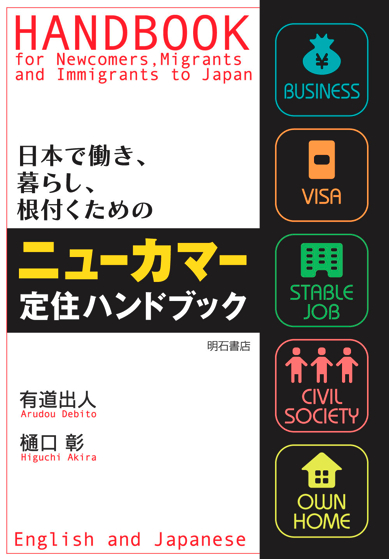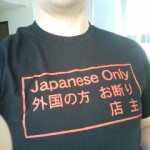mytest






![]()

UPDATES ON TWITTER: arudoudebito
DEBITO.ORG PODCASTS now on iTunes, subscribe free
Hi Blog. The Japan Times this week published a very nicely-considered article on something brought up on Debito.org in February: The Little Black Sambo controversy, and how it was being taught without any racial sensitivity or historical/cultural context, to Japanese pre-schoolers, regardless of concerns raised about its appropriateness.
For the record, I believe LBS is a work of history and as such should not be “banned”. It should, however, whenever used always be placed in historical context, and seen as materiel to enlighten people about the prejudices of the day. I have never seen it done so in Japan. In fact, the republisher Zuiunsha — which appears to have just appropriated the book from the previous Japanese publisher and republished it for fun and profit — doesn’t even offer a disclaimer or a foreword in the book explaining why this book has been problematic; existentially, it’s just a book they can get rich off of. Who cares if some people might be adversely affected by it?
Hence my attempt, mentioned below, of providing not historical context, but through parody putting the shoe on the other foot for empathy, as “Little Yellow Jap”. That has occasioned cries of “racism” by the noncognizant. But the Japan Times essayist below gets it. Excerpt of article follows. Arudou Debito in Sapporo
/////////////////////////////
Japan Times illustration (tiff file, click on squares if not visible in your browser):
THE ZEIT GIST
‘Sambo’ racism row reignites over kids’ play
The 1899 book still making waves in 21st-century Japan
The Japan Times, April 13, 2010 (excerpt)
By MATTHEW CHOZICK
“Little Black Sambo, Sambo, Sambo/His face and hands are completely black/Even his butt is completely black.”
Word of nursery-schoolers in Saitama Prefecture chanting a “Little Black Sambo” song — “akin to what might be taught by a white supremacist group” — spread online recently, prompting 21st century-style activism: Facebook postings, blogosphere commotion, an online petition, CCed e-mails to Tokorozawa City Hall. In a phone call, a Midori Hoikuen nursery school employee admitted to having read and then re-enacted — with toddlers — the best-selling children’s book “Little Black Sambo” (known here as “Chibikuro Sanbo”). The re-enactment’s song lyrics, as printed above, were allegedly translated by a biracial child’s concerned parent and then uploaded onto Facebook.
Since the first, Victorian-era printing of “Little Black Sambo,” its pejorative title and caricature illustrations — pitch-black faces with bulging red lips, white balloon eyes — have been a perennial bone of contention for civil-rights proponents in the U.S. and, later, Japan. Harlem Renaissance writer Langston Hughes described the text in 1932 as “amusing undoubtedly to the white child, but like an unkind word to one who has known too many hurts to enjoy the additional pain of being laughed at.”…
Activist and Japan Times columnist Debito Arudou uploaded a parody onto his Web site, debito.org, titled “Little Yellow Jap” (“Chibi Kiiro Jappu”). Arudou asks, “What if your race was depicted in the same way as in this book?”
Redolent of Audrey Hepburn’s bucktoothed Japanese neighbor played by Mickey Rooney in “Breakfast at Tiffany’s,” Arudou’s characters have enormous eyeglasses, exaggeratedly yellow skin and big front incisors. In Arudou’s parody, the original’s tigers become monkeys, butter is miso, one character is garbed in sumo getup and another in a Hello Kitty apron.
Arudou’s artwork succeeds, like the book it lampoons, in being both somewhat offensive and also kind of cute. This conflation is important because cuteness directs feelings of fondness and intimacy toward items of all kinds, not just puppies. Indeed, throughout “Little Black Sambo” there are numerous physical characteristics that humans are biologically programmed to find cute. According to Austrian Nobel Laureate Konrad Lorenz, these include “predominance of the brain capsule, large and low-lying eyes, bulging cheek region.”…
Whether or not this book is innocent of bigotry will continue to be debated, but in the meantime it may be a good idea to foster a critical atmosphere in which “Little Black Sambo,” held in the hands of a competent teacher, can educate children while charming their imaginations. If you teach, get a debate rolling. Bring a copy of “Little Black Sambo” to class along with Arudou’s illustrations. Let’s not be hasty in making pre-Amazon.com kindling out of a potentially valuable pedagogic tool…
Full article at http://search.japantimes.co.jp/cgi-bin/fl20100413zg.html
The parody, “Little Yellow Jap”, is downloadable from
https://www.debito.org/chibikurosanbo.html
ENDS
6 comments on “Japan Times on “Little Black Sambo” controversy, cites Debito.org’s parody “Little Yellow Jap””
Midori Hoikuen never did reply to my email, but since I never got a non-delivery message either, I assume they got it.
I don’t have a problem with this book being in print necessarily. I read it when I was a kid, and don’t think I’ve turned out especially racist because of it. I don’t think the book itself teachs anything negative about people of African or Indian descent… but the WAY in which it was being taught in this case bothers me. To describe another human being as “completely black, even his butt is completely black” is incredibly offensive, they’re teaching those kids from a very early age to judge by appearances only and to characterize a person by skin color.
And while I don’t necessarily have a problem with the book being available to purchase if an individual desires it, it seems that education institutions should be choosing stories which have a more postive moral value for the children. Simply KNOWING that this book is considered controversial by someone, somewhere, should have raised a red flag. There is NO reason that Little Black Sambo needed to be taught in this case. Another story, ANY other story would have done just as well. Why not Momotaro or the Three Little Pigs? Or better yet, why not find a story which positively introduces another culture or includes children from different backgrounds playing together or cooperating? It just seems like a really poor choice of material on the hoikuen’s part.
— Or it may be that blind spot that you’re displaying, “Well, I had it when I was a kid, and I didn’t turn out racist.” Problems with that logic are 1) few people admit (or even believe) they themselves are racist under any circumstances, and 2) there are lots more mitigating factors in other societies (such as anti-discrimination education, or even just the opportunity to make friends with minorities) that will counteract much of the subtle prejudices promoted by the likes of the Sambo genre — most of which Japanese society lacks.
I’m not saying you are racist. Problem is, likewise the hoikuen is saying they’re not racist. What gives you but not them the same plausible deniability? Gotta combat that dynamic too, or we’re not convincing these people who just won’t see the potential bigotry inculcated in impressionable young people.
I, personally, believe all people are racist, in at least some meaning of the word. We all have had upbringings that exposed us to sorting and classifying people (not necessarily in an overt way) by race and origin. The question is, what do we do with our racism. Do we acknowledge it and try to prevent negative behaviors that might hurt others or do we pretend that we are not racist and deny the feelings of those who might feel a slight over some situation? The book is racist, the method of teaching was racist and I feel that the teachers, or at least the institution is in denial. Sadly, until the teachers feel racially slighted in some way, they will likely continue to deny their racism.
— And even then. I keep seeing the dynamic where the “Victimhood” tendency makes people even more intransigent. The most commonly-cited slight is going overseas and being seated by the toilet (or some other unfavorable place) in a restaurant, because the management allegedly has a “thing” about Asians and/or Japanese. I’ve heard this many times, even on television. Then the conclusion is that racism is everywhere and we can’t do anything about racism in Japan if it even goes on unabated in the West. This cognitive dissonance, the lack of “Do Unto Others”, makes the logical Circle of Life complete and deprives our side of potential allies and empathizers. And that situation is a real shikata ga nai.
Potentially valuable pedagogic tool-but to elementary school students or above. What is taught to day care kids , age 0-5, remains not on conscious , but on subconscious level, hence the unexplained coldness towards people of that race, or foreigners at all, later in life. That’s why there’s a saying thet the first 7 years of one’s life are the most important ones.
If the daycare center wants to teach kids about race, let them interact and build their own bridge between them and the person from a different race.Thus, they will build their own perception of that race.
I don’t get what exactly is cute in a book focusing on the color rather than the physical features of the main character. There is indeed kind of genetic program, aiming at the arousal of parental, protective feelings in order to protect the children. The point is that the audience of this book is way too young to have such feelings, and that at the end they will remember that the main character was “black” and that was funny, because even his “butt was black” (butt!hahaha!). Ijou, okashii, hen, waraeru feelings will become subconsciously corelated to the idea of this race, and later on they will evolve into “hiku”, “kyohi” and “sabetsu” while the person will keep saying “sabetu ja nai yo” and will be convinced of that (sounds familiar?).
I have to ask a favor, though-since I’m not a native speaker, may I ask Debito-san to fix my English in order to become more readible and easier to understand. I’m afraid some of my posts are very hard to understand…
— Your English is fine today. It’s not my job to fix others’ comments, so please proofread your own, and do so calmly even if you’re annoyed about other topics du jour.
I agree with Mark Hunter above… I never meant to say that I was perfectly colorblind, of course I am not and I don’t think anyone CAN be… whether it’s an open hatred or an assumption that the black guy’s going to be decent at basketball, I think everyone has SOME kind of prejudice at some level. Completely eliminating that is probably not going to happen in our lifetimes, but I think anyone reading this site would agree that taking stpes is important.
I just don’t think that eliminating the book from existance is the answer either. That would be no different than Japanese schools refusing to teach about Japanese war crimes, comfort women, etc. Covering up mistakes of the past isn’t going to help anyone learn from them. And I don’t think that banning books is right in any case… a person has the right to write about their ideas, whatever they are, an those ideas should be available for adults to purchase and read, and even to teach their own children in their own home if they want to.
The issue here is that it was being taught in a licensed educational institute, to children too young to POSSIBLY unerstand all of the implications. Banning the book from educational use below, say, the high school level? would be a perfectly acceptable solution IMO.
We may have already had the desired effect at this particular institution. I seriously doubt that they chose the story with MALICIOUS intent (just dumb ignorance and blind nostagia?) and now they’ve had to deal with phone calls and emails and at least one family of a student who had a problem with it. I bet they’ll choose something different next year, simply because it’s “mendoukusai” to deal with complainers. Not the BEST result in the world, but I imagine that a lot of people in the US weren’t too happy with the civil rights movement either, for example, when it was just getting started. Small steps… getting this in the Japan Times is a pretty good one too. Maybe not as good as a Japanese-language paper, but definitely on the way.
Kimberly, I agree don’t ban the book. However, I’d limit its use to classes specifically designed to teach about racism.
This is a terrible children’s book with negligible nostalgic merit that is far outweighed by obvious racist and imperialist connotations. It doesn’t matter that the original context was about a Tamil boy and wasn’t specifically aimed at Africans – the meme crossed the Atlantic and took on a life of its own by morphing into the typical “darky imagery” we see exemplified by grotesque blackface minstrel shows – the exact same imagery used in the current iteration of Chibikuro Sambo books currently circulating in Japan.
I never promote censorship, but honestly, what moral lessons does this LOADED children’s book offer that can’t be found elsewhere? If you can name one please, enlighten me. Stop calling it a children’s book and reduce it to nothing more than a footnote in history that can be referred to by college level students when they’re writing their papers about subversive forms of racial discrimination in popular media.
Black sambo may have been a trifling matter in Japan’s halcyon days before immigration reform in the 90’s, but with the increasing presence (however incremental that increase may be in population statistics alone) of multiracial, multicultural children of a whole spectrum of complexions, the situation has become truly untenable.
If it takes “Chibi Kiiro Jappu” to shock people into stopping and thinking for a moment, then I’m all for it. So I am definitely pro-swift-kick-to home team’s-collective-be-hind if that’s what it takes to get people to even care about this issue.